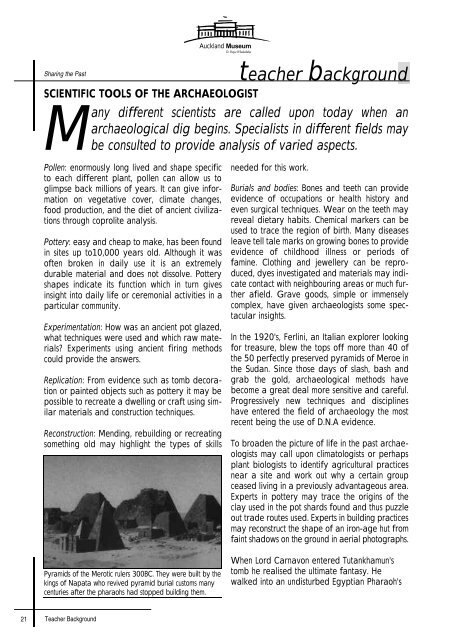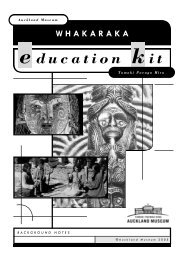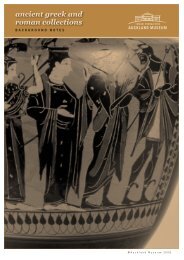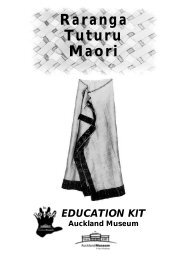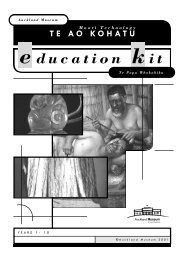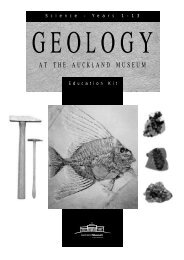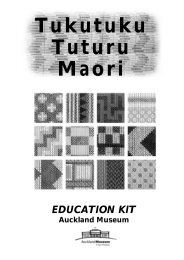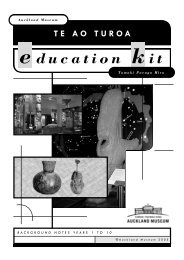You also want an ePaper? Increase the reach of your titles
YUMPU automatically turns print PDFs into web optimized ePapers that Google loves.
Sharing <strong>the</strong> Past<br />
Pollen: enormously long lived and shape specific<br />
to each different plant, pollen can allow us to<br />
glimpse back millions of years. It can give information<br />
on vegetative cover, climate changes,<br />
food production, and <strong>the</strong> diet of ancient civilizations<br />
through coprolite analysis.<br />
Pottery: easy and cheap to make, has been found<br />
in sites up to10,000 years old. Although it was<br />
often broken in daily use it is an extremely<br />
durable material and does not dissolve. Pottery<br />
shapes indicate its function which in turn gives<br />
insight into daily life or ceremonial activities in a<br />
particular community.<br />
Experimentation: How was an ancient pot glazed,<br />
what techniques were used and which raw materials?<br />
Experiments using ancient firing methods<br />
could provide <strong>the</strong> answers.<br />
Replication: From evidence such as tomb decoration<br />
or painted objects such as pottery it may be<br />
possible to recreate a dwelling or craft using similar<br />
materials and construction techniques.<br />
Reconstruction: Mending, rebuilding or recreating<br />
something old may highlight <strong>the</strong> types of skills<br />
21 Teacher Background<br />
<strong>Auckland</strong> <strong>Museum</strong><br />
Te Papa Whakahiku<br />
SCIENTIFIC TOOLS OF THE ARCHAEOLOGIST<br />
teacher background<br />
Many different scientists are called upon today when an<br />
archaeological dig begins. Specialists in different fields may<br />
be consulted to provide analysis of varied aspects.<br />
Pyramids of <strong>the</strong> Merotic rulers 300BC. They were built by <strong>the</strong><br />
kings of Napata who revived pyramid burial customs many<br />
centuries after <strong>the</strong> pharaohs had stopped building <strong>the</strong>m.<br />
needed for this work.<br />
Burials and bodies: Bones and teeth can provide<br />
evidence of occupations or health history and<br />
even surgical techniques. Wear on <strong>the</strong> teeth may<br />
reveal dietary habits. Chemical markers can be<br />
used to trace <strong>the</strong> region of birth. Many diseases<br />
leave tell tale marks on growing bones to provide<br />
evidence of childhood illness or periods of<br />
famine. Clothing and jewellery can be reproduced,<br />
dyes investigated and materials may indicate<br />
contact with neighbouring areas or much fur<strong>the</strong>r<br />
afield. Grave goods, simple or immensely<br />
complex, have given archaeologists some spectacular<br />
insights.<br />
In <strong>the</strong> 1920's, Ferlini, an Italian explorer looking<br />
for treasure, blew <strong>the</strong> tops off more than 40 of<br />
<strong>the</strong> 50 perfectly preserved pyramids of Meroe in<br />
<strong>the</strong> Sudan. Since those days of slash, bash and<br />
grab <strong>the</strong> gold, archaeological methods have<br />
become a great deal more sensitive and careful.<br />
Progressively new techniques and disciplines<br />
have entered <strong>the</strong> field of archaeology <strong>the</strong> most<br />
recent being <strong>the</strong> use of D.N.A evidence.<br />
To broaden <strong>the</strong> picture of life in <strong>the</strong> <strong>past</strong> archaeologists<br />
may call upon climatologists or perhaps<br />
plant biologists to identify agricultural practices<br />
near a site and work out why a certain group<br />
ceased living in a previously advantageous area.<br />
Experts in pottery may trace <strong>the</strong> origins of <strong>the</strong><br />
clay used in <strong>the</strong> pot shards found and thus puzzle<br />
out trade routes used. Experts in building practices<br />
may reconstruct <strong>the</strong> shape of an iron-age hut from<br />
faint shadows on <strong>the</strong> ground in aerial photographs.<br />
When Lord Carnavon entered Tutankhamun's<br />
tomb he realised <strong>the</strong> ultimate fantasy. He<br />
walked into an undisturbed Egyptian Pharaoh's


